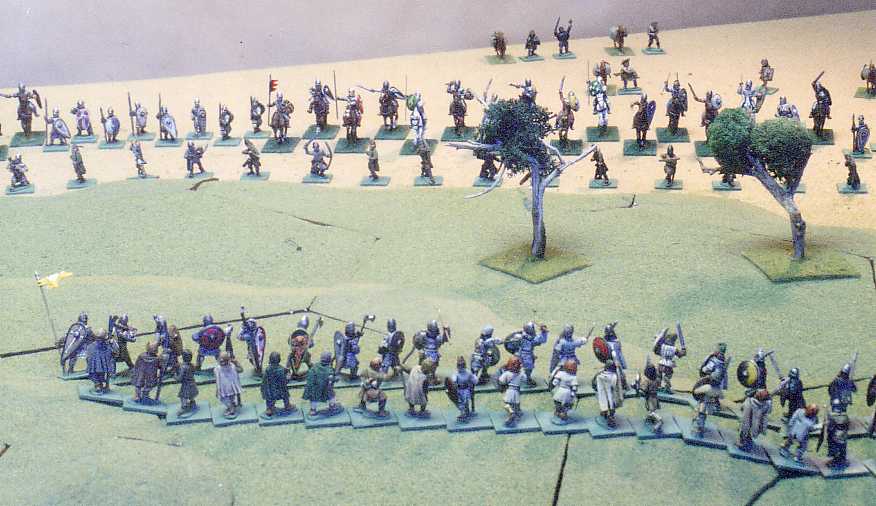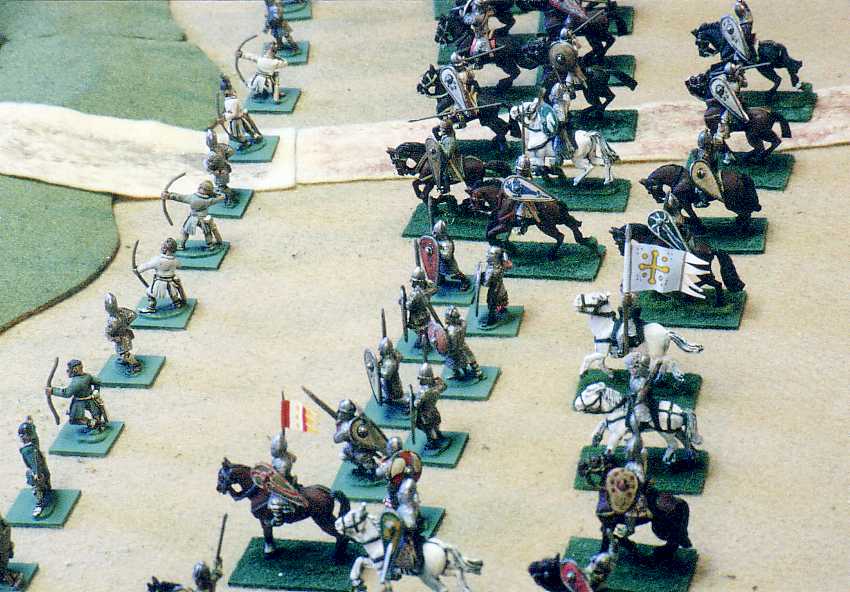Turn by turn development of the battle of Hastings
using the wargame rules The Art of War

View from French right and English left
This time I inserted plenty of marksmen on the Norman side, and reduced the number of spearmen accordingly. The army sizes remained the same.
The reworked structure of the Franco-Norman army is as follows:
Breton left:
1,344 marksmen (c. 1/4 light crossbowmen, the balance unarmored archers)
768 heavy infantry spearmen
800 cavalry
Norman center:
1,536 marksmen (1/3 light crossbowmen; 2/3 unarmored archers)
1,536 heavy infantry spearmen
1,700 cavalry
French right:
1,216 marksmen (c. 1/4 light crossbowmen, the balance unarmored archers)
512 heavy infantry spearmen
550 cavalry
The English army remains unchanged.

Detail of Franco-Norman starting postions
The Norman center is the primary subject in this shot: note the two forward cavalry units, interspersed with three heavy infantry units: William's reserve is in the rear. The French right cavalry are in the foreground of this picture. The continuous line of open-order marksmen are out in front. The number I used (c. 3,000 archers and 1,000 crossbowmen) barely fit the frontage by slightly wrapping around the ends of the English line into the woods.

English left and French right.
The French cavalry are flanked on their right by their own heavy infantry, and on their left by the righthand-most Norman heavy infantry unit.

English center and Norman center.
Harold's reserve, with his banners, is in the rear (foreground of this picture). William's papal banner can be seen in the extreme Norman rear with his cavalry reserve.

English right and Breton left
The Breton cavalry are flanked on their right by the lefthand-most Norman heavy infantry unit, and the Breton heavy infantry - barely seen on the extreme right in this picture (the balance of both wings are cut off in this view).

Detail of William's center
The papal banner is held beside the duke. The two Norman cavalry units and the central heavy infantry unit are in front of William's cavalry reserve.

The battle opens
I played the Franco-Norman missile fire by starting at 11 to 15" (110 to 150 yards). There was very little effect upon the English line, because it was drawn up in a shieldwall. On the next turn the invader marksmen advanced to within 100 yards (6 to 10"), and their missilefire was much more effective. They would have stayed there and kept shooting until their quivers ran dry, but the English stepped forward on the next turn and got within hand missile range (5", or 50 yards). This picture shows the positions of both armies just before the mutual exchange of very heavy missilefire. There are virtually no Franco-Norman casualties at this point, but a number of routed and dead English, which you can see scattered on the top of the hill.
Note that in places the invader marksmen have crammed together closer than open order. The front became cramped as they closed on the English position. In gaming terms, close order (less than full open order) marksmen cannot get full effect when they shoot: I totalled up the figures (c. half a dozen) which were in violation of the open order rule and cut their hits in half: only the front ranks were actually able to see and shoot.






